When most people think of Louisiana, they think of jazz music or cajun dishes like jambalaya or gumbo. Still, others think about Louisiana’s rich natural resources. The Bayou State is a lush territory that consists of coastal marshlands, hilly regions, and flat lowland plains. You can find many plant and animal species in the state, including alligators and pelicans. Louisiana is also home to many different arachnids ranging from fishing spiders to orb-weavers. Here is a list of 10 spiders in Louisiana that you may encounter during your next trip to the state.
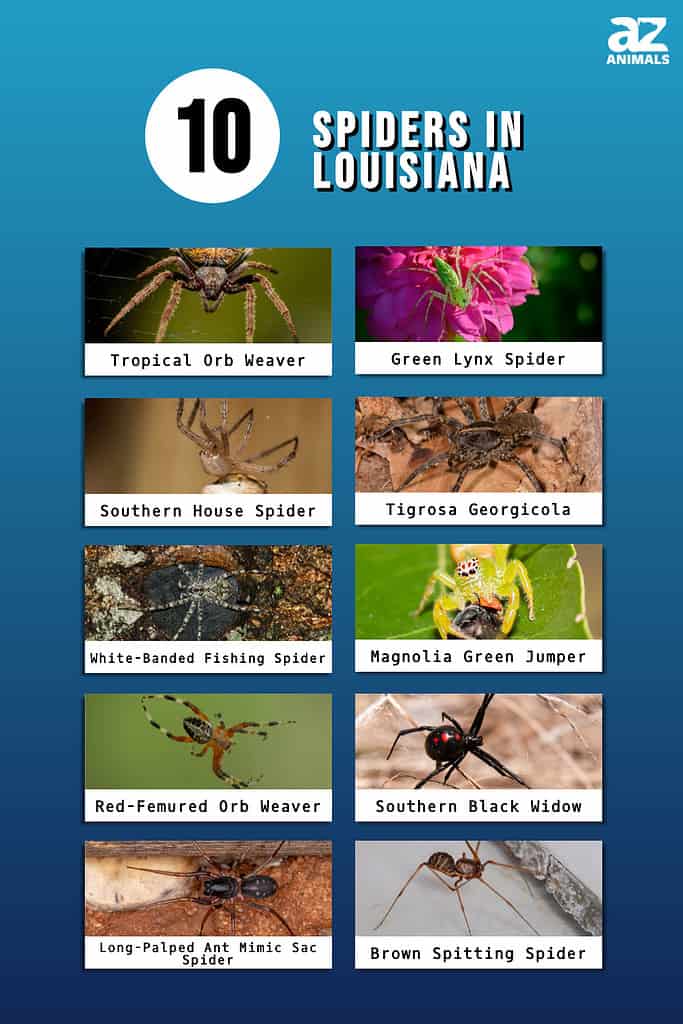
#10: Tropical Orb Weaver
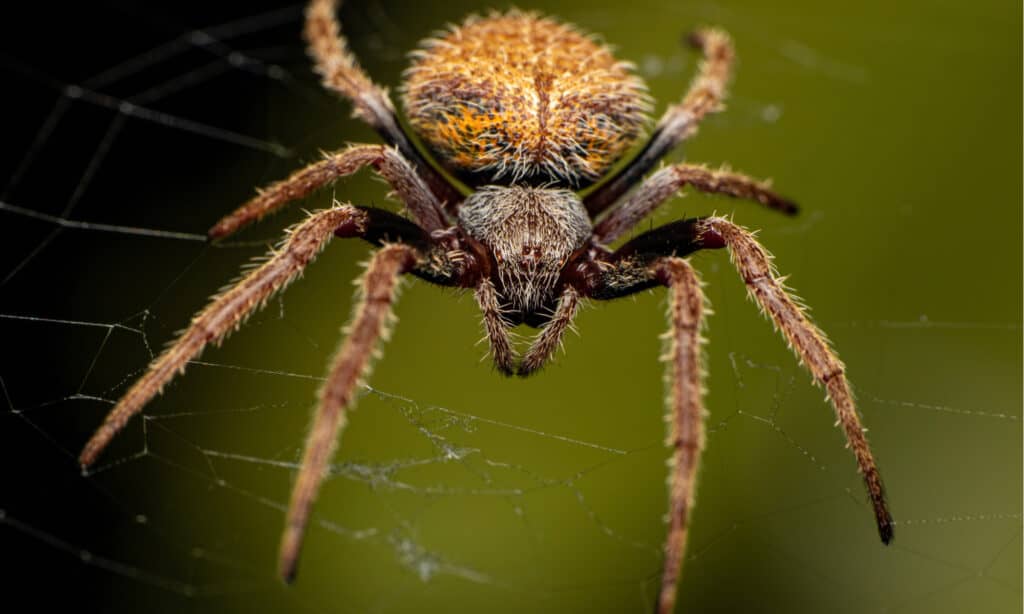
The tropical orb weaver comes in various colors and features various markings.
©Tommy Daynjer/Shutterstock.com
Eriophora ravilla, or the tropical orb-weaver, is a member of the orb-weaver family Araneidae. It is widely distributed throughout the Americas, from the United States to Brazil.
Female tropical orb-weavers measure up to 25 millimeters in length, while males measure about half that size. Of all the spiders in Louisiana, tropical orb-weavers rank as one of the most difficult to identify because they vary in appearance. Most appear dull brown with no specific markings, while others have a yellowish-green diamond-shaped marking on their abdomens. Some feature a white abdominal stripe, while others appear orange and green with black spots on their abdomen.
At night, tropical orb-weavers build large webs that they use to catch prey. Their bite is harmless to humans but may cause some pain and swelling.
#9: Green Lynx Spider
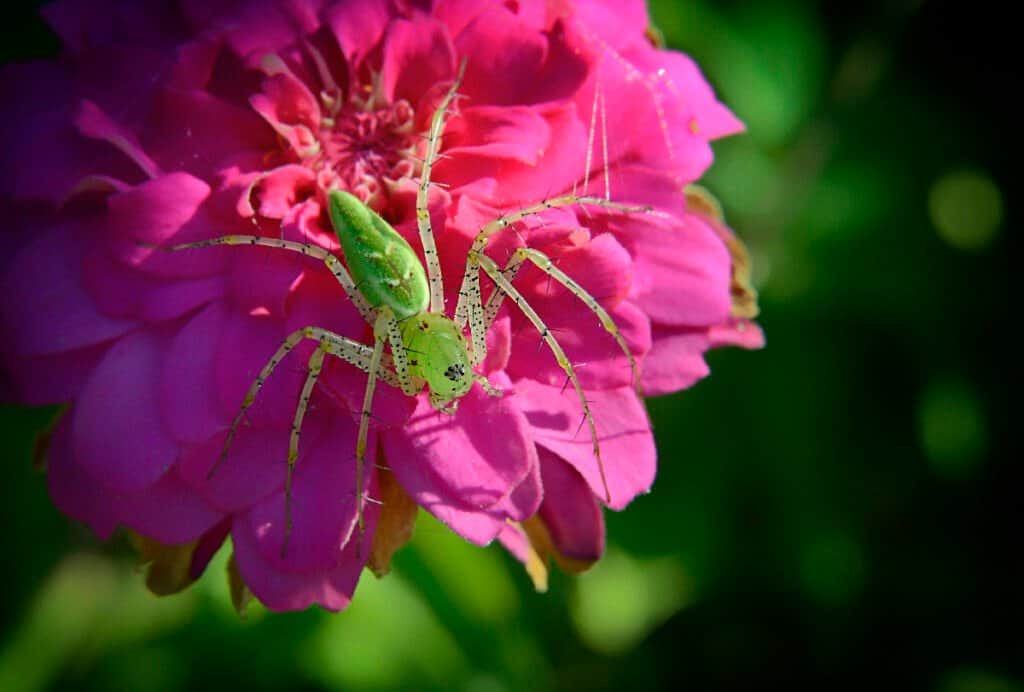
The green lynx spider is the largest species of lynx spider in North America.
©iStock.com/Lois_McCleary
The green lynx spider, Peucetia viridans, belongs to the lynx spider family Oxyopidae. Of all the lynx spiders in Louisiana, it easily ranks as the largest. It ranges throughout the southern United States as well as Mexico, Central America, and Jamaica.
Female green lynx spiders measure up to 22 millimeters in length, while males measure around 12 millimeters long on average. Green lynx spiders often sport a red marking between their eyes as well as several red spots on their bodies. Depending on their environment or the time of year, their bodies appear either lime green or yellow. Additionally, their abdomens feature six chevron markings with the points facing forward.
You can often find green lynx spiders resting on green plants. They actively hunt insects such as moths and do not build webs to capture their prey. While mildly painful, their bite poses no threat to humans.
#8: Southern House Spider
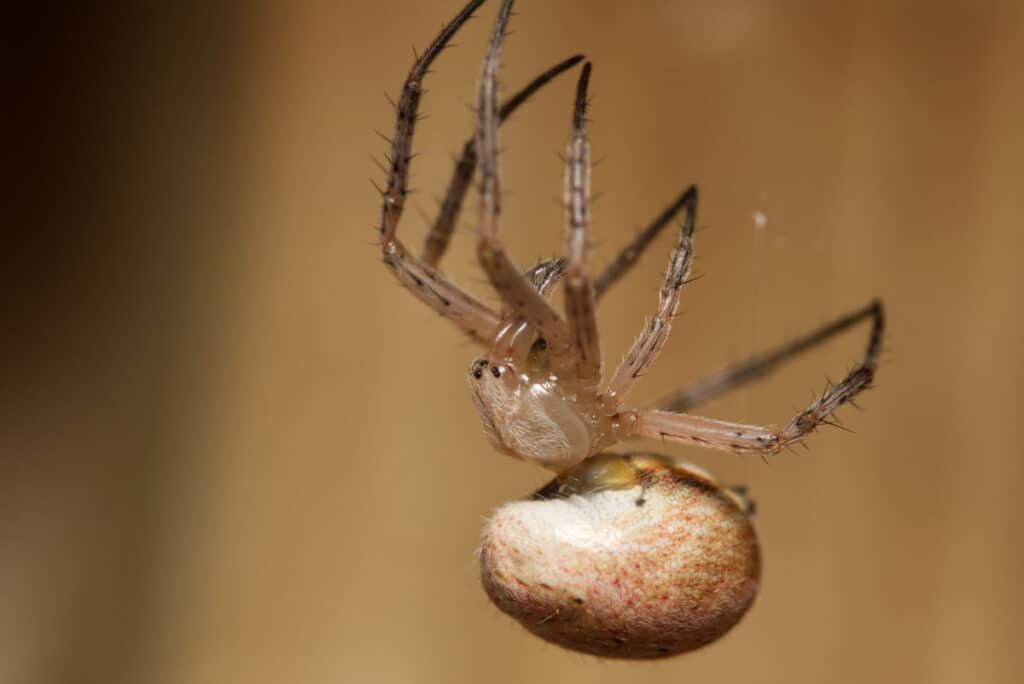
Southern house spiders often get mistaken for brown recluses due to their similar markings.
©Kala Stuwe/Shutterstock.com
Kukulcania hibernalis is more commonly known as the southern house spider. A member of the crevice weaver spider family Filistatidae, the southern house spider is one of the most common spiders in Louisiana. Its range extends from the southern United States to Argentina.
Female southern house spiders measure from 12 to 18 millimeters long, and males measure 8 to 12 millimeters long. People often mistake them for brown recluse spiders due to their similar appearance. You can differentiate the two since southern house spiders do not sport a violin-shaped marking on their abdomen. Their bodies are almost uniformly brown, with females generally appearing darker than males while males have longer legs.
As their name suggests, female southern house spiders often build their radial-style webs of non-sticky silk inside human dwellings. However, you’re unlikely to encounter them because they construct their webs around crevices.
#7: Tigrosa Georgicola

Like other members of its genus, Tigrosa georgicola can be quite aggressive.
©Marshal Hedin / Creative Commons – License
Tigrosa georgicola is a member of the wolf spider family Lycosidae. It is one of several spiders in Louisiana that lack a common name and so only goes by its scientific designation. While originally discovered in Georgia, its range covers most of the southeastern United States.
Adult females typically measure between 16 and 22 millimeters long, while males measure 10 to 17 millimeters in length. Their bodies are dark brown aside from a light brown stripe through the center of the cephalothorax. They also sport light orangish-brown stripes on the bottom of their abdomen.
You can find Tigrosa georgicola spiders in woodlands, particularly under logs or in leaf litter. Like other members in their genus, they are known to be quite fierce. Instead of constructing webs, they actively hunt their prey using a combination of strength, speed, and stealth. Their bite, while mildly painful, is not medically significant.
#6: White-Banded Fishing Spider
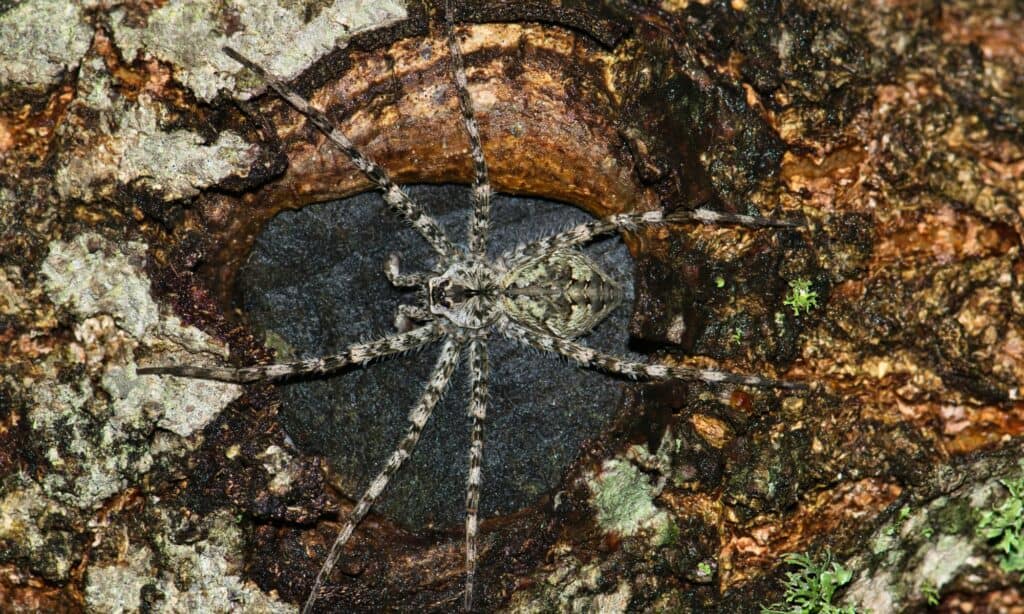
The white-banded fishing spider can create an air pocket under its abdomen that allows it to dive underwater to catch prey.
©iStock.com/Brett_Hondow
The white-banded fishing spider, Dolomedes albineus, belongs to the nursery web spider family Pisauridae. You can find these semi-aquatic spiders throughout Louisiana and much of the United States.
Female white-banded fishing spiders typically measure 23 millimeters long, and males average 18 millimeters long. Although their color varies, most specimens appear brown or mossy green, while some females look almost completely white. They get their name from the white band located in the space below their eyes and around their jaws.
White-banded fishing spiders use webs to hold their egg sacs and not to hunt prey. They actively hunt for insects and small vertebrates using a variety of tactics. For example, they may use their legs as fishing rods to snag prey in the water or even run across the surface to capture insects. Occasionally, they will dive into the water to capture small fish.
#5: Magnolia Green Jumper
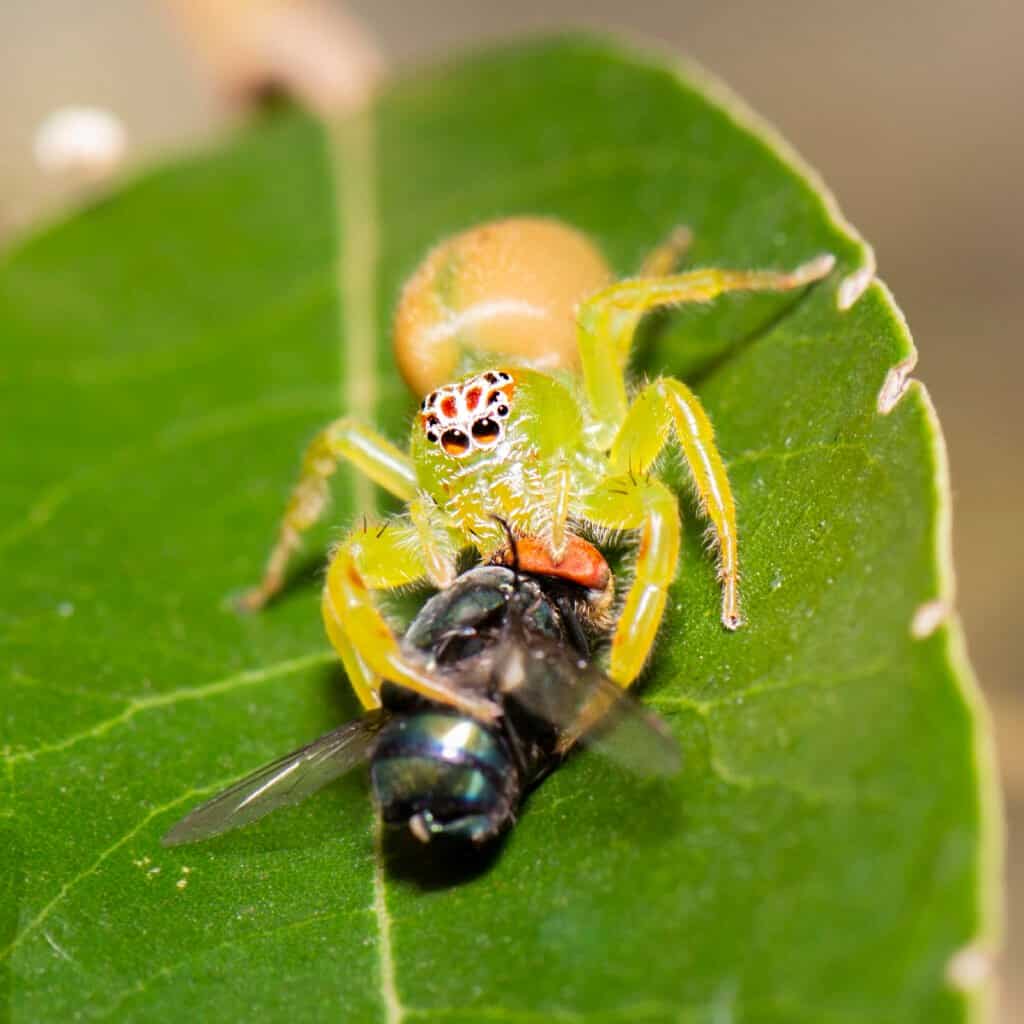
The magnolia green jumper gets its name from its bright green color and amazing jumping ability.
©iStock.com/RobertDowner
Lyssomanes viridis, or the magnolia green jumper, is a member of the jumping spider family Salticidae. It ranges throughout the southeastern United States and parts of Central America.
Magnolia green jumpers are quite small, with females measuring 7 to 8 millimeters long and males measuring 5 to 6 millimeters long. Their name is derived from their distinctive pale, almost translucent green color. They feature a patch of red, orange, or yellow scales on the crown of their head and several dark spots on their abdomen. Compared to other jumping spiders, they possess long legs in relation to their body size and large mouthparts and eyes.
As evidenced by their common name, you can often find magnolia green jumpers on the leaves of magnolia trees. Given their short jumping range, they often ambush prey from behind. Their bite also poses no threat to humans due to their small size.
#4. Red-Femured Orb Weaver

The first segment of each leg on a red-femured orb-weaver is bright red.
©samray/Shutterstock.com
Also known as the spotted orb-weaver, the red-femured orb weaver is another member of the Araneidae family to make our list of spiders in Louisiana. Its scientific name, Neoscona domiciliorum, refers to the fact that it often lives in buildings.
Female red-femured orb weavers measure 7 to 16 millimeters long, while males average about 8 millimeters in length. They feature a white or yellow marking on the back of their abdomen with broad, black lateral stripes on either side. Their name comes from the fact that the first segment of each leg appears red, while the rest are either black or grey.
Red-femured orb weavers create vertically oriented webs that measure around 20 inches in diameter. They catch a wide variety of insect prey, including flies, mosquitoes, and moths. Thankfully, their bite is not medically significant and poses little threat to humans.
#3. Southern Black Widow
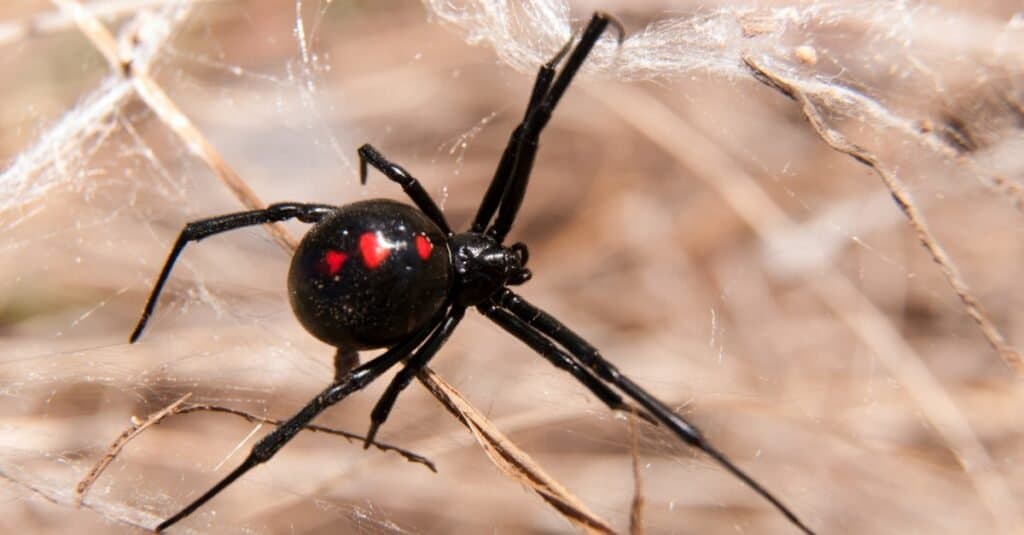
Southern black widow spiders rarely kill people, but it’s important to get medical attention as soon as possible.
©Sari ONeal/Shutterstock.com
The southern black widow spider, Latrodectus mactans, is also known as the shoe-button spider. It is one of the most venomous spiders in Louisiana and can also be found throughout much of North America.
Female southern black widow spiders measure from 8 to 13 millimeters long, and males measure 3 to 6 millimeters in length. Their mostly black body features a distinctive red hourglass-shaped marking on the bottom of their abdomen. They also often sport an orange or red patch above their spinnerets on the top of their abdomen.
Southern black widows get their name both from their geographic distribution and because they often kill and cannibalize males shortly after mating. They build webs both to hold their prey and capture mates. Their venomous bite affects their prey’s nervous system. While rarely fatal, it can cause muscle aches, difficulty in breathing, and nausea in humans.
#2: Long-Palped Ant Mimic Sac Spider
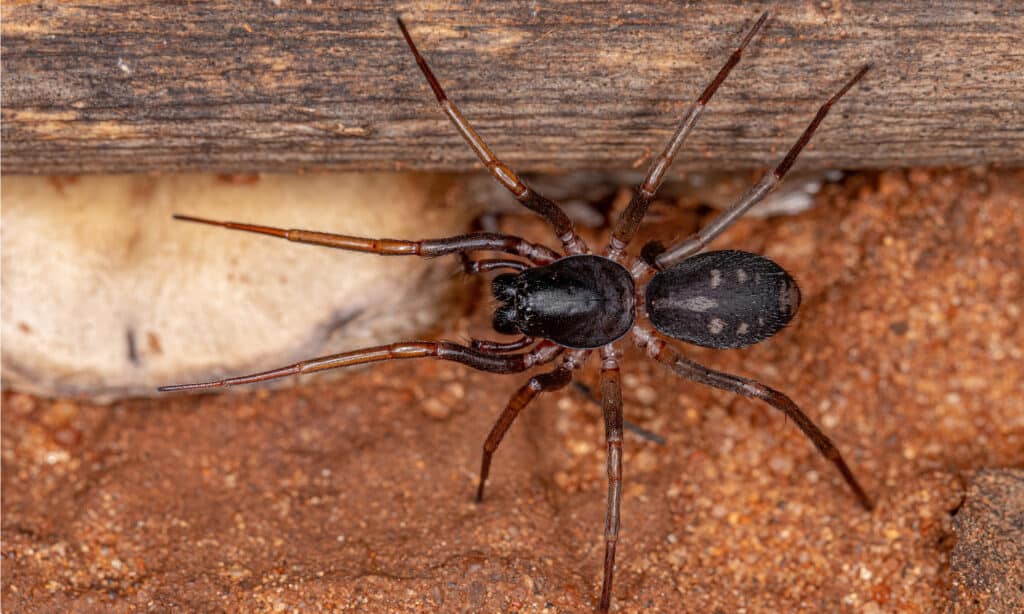
The long-palped ant mimic sac spider imitates the appearance of an ant by using its front legs like antennae.
©Vinicius R. Souza/Shutterstock.com
The long-palped ant mimic sac spider, Catianeira longipalpa, belongs to the corinnid sac spider family Corinnidae. It can be found throughout the eastern half of the United States and parts of Canada.
Adult females grow up to 13 millimeters long, while males measure between 3 and 6 millimeters long. Their black abdomen features at least four lateral white or light grey stripes. Meanwhile, their cephalothorax varies from black to brown to greyish-white.
As its name suggests, the long-palped ant mimic sac spider engages in strange behavior that makes it resemble an ant. Specifically, it uses its front two legs similarly to how ants use their antennae. Although the reason for this is not entirely known, it’s likely done to allow the spider to sneak up on unsuspecting ants and summarily ambush them. While threatening to ants, its bite poses little threat to humans other than mild pain.
#1. Brown Spitting Spider
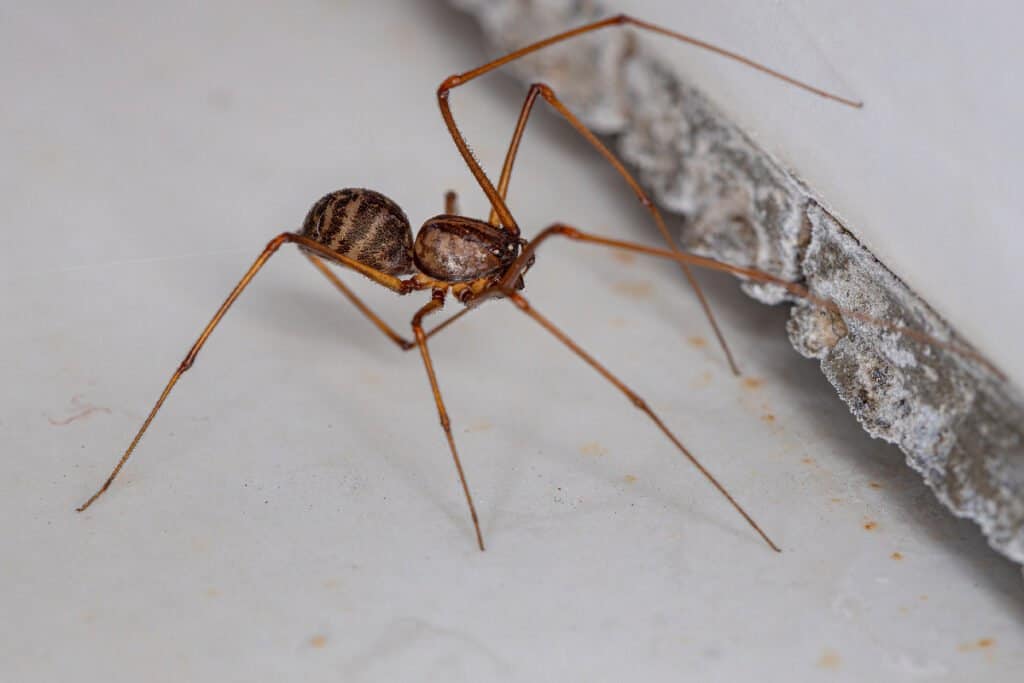
The brown spitting spider catches prey with venomous silk that it shoots from its fangs.
©iStock.com/ViniSouza128
The brown spitting spider, Scytodes thoracica, belongs to the spitting spider family Scytodidae. It is a cosmopolitan species that can be found throughout much of the world, particularly in warmer regions or inside homes in colder habitats.
Adult brown spitting spiders measure from 3 to 6 millimeters long, with females measuring slightly larger than males. Unlike most other spiders, they only have six eyes. They typically appear light brown and feature black markings on their cephalothorax, legs, and abdomen.
The brown spitting spider uses one of the most unique prey capture methods of all the spiders in Louisiana. To compensate for its slow speed, it shoots venomous, sticky silk over its prey from a distance. It tends to hunt at night when many insects are less active. Due to their small size, brown spitting spiders have a bite that poses little threat to humans.
Summary of 10 Spiders in Louisiana
| Rank | Spiders |
|---|---|
| 1 | 1. Brown Spitting Spider |
| 2 | 2: Long-Palped Ant Mimic Sac Spider |
| 3 | 3. Southern Black Widow |
| 4 | 4. Red-Femured Orb Weaver |
| 5 | 5: Magnolia Green Jumper |
| 6 | 6: White-Banded Fishing Spider |
| 7 | 7: Tigrosa Georgicola |
| 8 | 8: Southern House Spider |
| 9 | 9: Green Lynx Spider |
| 10 | 10: Tropical Orb Weaver |
The photo featured at the top of this post is © Crystal Kirk/Shutterstock.com
Thank you for reading! Have some feedback for us? Contact the AZ Animals editorial team.







